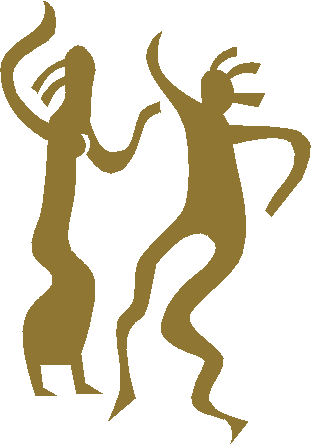PHILIPPINE
BALLROOM  Filipinos have always been copious followers of the American
colonizers, since the turn of the century. So much so that whatever dances were in vogue
in the United States were always copied and made popular in the Philippines, almost
immediately. Filipinos have always been copious followers of the American
colonizers, since the turn of the century. So much so that whatever dances were in vogue
in the United States were always copied and made popular in the Philippines, almost
immediately.
For centuries before then, our
folks danced for every occasion depicting, celebrating, commemorating life’s
special moments: a birth, a christening, introduction to adulthood, a wedding, the
winning of a war, festivals of nature.
With the coming of the Spanish
to our shores, the dancing did not stop; it only took a different form. From Europe were
introduced the Court dances such as the Waltz, the Mazurka, the Polka, and various forms
of quadrilles which became standard dances in all social occasions of the privileged
class.
The same dances worked their way
into the mainstream of society, adapted and adjusted to by our own people. Ms.
Francisca Reyes-Tolentino, National Artist for 1973 records these dances in her
book Philippine National Dances, which includes old-time Philippine ballroom
dances as the Los Bailes de Ayer, Chotis, Inkoy-Inkoy, Lubi-Lubi,
Pasakat, Polka Sala, Redoba and the Rigodon.
Upon the entry of the Americans
before the end of the 19th century, the differences in the dances of the folk and the
upper classes almost ceased to exist. Education was so widespread that almost everyone was
exposed to the new music and dances, Western culture. Children learned, sang and danced
American rhymes and tunes.
Not surprisingly, the younger
generation had also acquired the taste for the newer ballroom dances -- the Tango, the
Foxtrot, the Charleston, the Quickstep.
Centuries of subjugation by
Western colonizers had taken its toll. Filipinos had tended to simply follow instead of
lead. The nation’s independent spirit was almost squelched. Dances were merely
copied, instead of developed.
Much later, practically every
one in the growing towns and cities were jitterbugging and dancing just like the Americans
were on the continent.
The end of the second world war
brought along new hope. New attitudes for a better future were reflected in the
dances. Many local music bands rose to popularity as they played the modern
Western music.
Dancers gained prominence
through their suave style and complicated footwork. One of these groups was
The Big 4, composed of Chito Feliciano, Tito Garcia, Louie Ysmael, and Archie
Lacson. All of them, except for the late Chito Feliciano, continue to lay
claim to being one of the best dancers in the country.
During the past decade, ballroom
dancing has seen a strong almost unexplainable following among Filipinos. Practically
everyone dances ballroom, or has at least tried it out.
In the mid-80s, a fine dining
restaurant - Tito’s - opened its doors to diners who wanted to dance after a
good dinner. It was soon followed by Pare and Ebiza, all in Makati. By the late 80s,
the rich matronas had made the ballroom their regular hangout. Many of them
were chaperoned by fine young men who also shared with them the finer pleasures of
dancing.
At the end of 1992, the ballroom
dancing scene started to change dramatically. Mt. Pinatubo had spewed its guts in June of
that year. As people in Central Luzon started to pick up their lives again, hordes
of young men and women (many barely out of high school) streamed to the cities
to look for jobs. Quite a number were attracted to the glitzy world of
ballroom dancing as dance instructors.
A few more restaurants opened
ballroom dancing nights, probably to cater to the growing number of dance enthusiasts in
the cities. The overhead expenses were not much, since guests normally brought their own
partners.
Then the outlets started
employing the attractive young men from Central Luzon as dancing partners for the
restaurant guests. Only allowances were given. The guests provided the tips. Thus, the
roving DI was born.
The spirit for innovation
and change was still alive, which could be discerned from the changes Filipinos made
in their dance.
The restless spirit to break the
chains of bondage gave rise to an almost frenzied dancing.
One can clearly see it even to
this day. Dances like the Jive and the Swing, for instance, are danced to a
much faster music tempo than they are in the US.
The independent spirit
reasserted it self through the new variations and syncopations of better dancers
which were popularized as other dancers copied them.
However, the main difference was
Filipinos ‘felt’ their way through dance, not consciously developing and
inventing new dances as the Western dancers were for a time. Filipinos developed the
dances as they were introduced, and innovating as they felt it.
Today, the ballroom dance scene
is replete with new variations only one would see here. Visiting Westerners sometimes
cannot even recognize the dances that their own people developed.
But then that’s the
beauty of dance. It is not constant and static. Dance is alive, as long as it
is being danced and innovated upon.
Filipinos may not have invented
the popular ballroom dances, but we surely are contributing our major share in the
development of these same dances, by injecting our own spirit and soul into each one of
them.
By
continuously doing so, we are
contributing to the world’s dance history.

|
